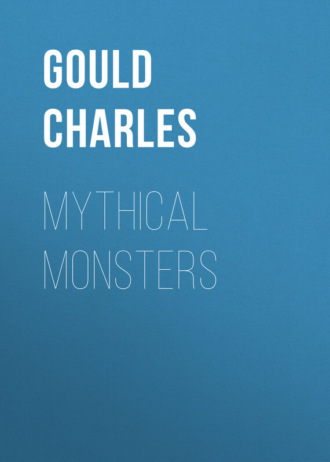 полная версия
полная версияMythical Monsters
Its food, ascertained by Von Brandt, and others, from portions remaining in the hollows of its teeth, consisted of leaves and needles of trees still existing in Siberia. The range of this species northwards was as extensive as that of the mammoth, but its remains have not yet been discovered south of the Alps and Pyrenees.
The investigation,49 made by M. E. Lartet in 1860, of the contents of the Grotto of Aurignac, in the department of the Haute Garonne, from which numerous human skeletons had been previously removed in 1852, shows that this animal was included among the species used as ordinary articles of food, or as exceptional items at the funeral feasts of the Palæolithic troglodytes. In the layers of charcoal and ashes immediately outside the entrance to the grotto, and surrounding what is supposed to have been the hearth, the bones of a young Rhinoceros tichorhinus were found, which had been split open for the extraction of the marrow. Numerous other species had been dealt with in the same manner; and all these having received this treatment, and showing marks of the action of fire, had evidently been carried to the cave for banqueting purposes. The remains of Herbivora associated with those of this rhinoceros, consisted of bones of the mammoth, the horse (Equus caballus), stag (Cervus elaphus), elk (Megaceros hibernicus), roebuck (C. capreolus), reindeer (C. tarandus), auroch (Bison europæus). Among carnivora were found remains of Ursus spelæus (cave-bear), Ursus arctos? (brown bear), Meles taxus (badger), Putorius vulgaris (polecat), Hyæna spelæa (cave-hyæna), Felis spelæa (cave-lion), Felis catus ferus (wild cat), Canis lupus (wolf), Canis vulpis (fox). Within the grotto were also found remains of Felis spelæa (cave-lion) and Sus scrofa (pig). The cave-bear, the fox, and indeed most of these, probably also formed articles of diet, but the hyæna seems to have been a post attendant at the feast, and to have rooted out and gnawed off the spongy parts of the thrown-away bones after the departure of the company.
In the Pleistocene deposits at Würzburg, in Franconia, a human finger-bone occurs with bones of this species, and also of other large mammalia, such as the mammoth, cave-bear, and the like.
And flint implements, and pointed javelin-heads made of reindeer horn, are found associated with it in the vicinity of the old hearths established by Palæolithic man in the cave called the Trou du Sureau, on the river Malignée in Belgium.
In the cavern of Goyet, also in Belgium, there are five bone layers, alternating with six beds of alluvial deposits, showing that the cave had been inhabited by different species at various periods. The lion was succeeded by the cave-bear, and this by hyænas; then Palæolithic man became a tenant and has left his bones there, together with flint implements and remains of numerous species, including those already enumerated as his contemporaries.
The Sabre-toothed Tiger or Lion. – This species, Machairodus50 latifrons of Owen, was remarkable for having long sabre-shaped canines. It belongs to an extinct genus, of which four other species are known, characterised by the possession of serrated teeth. The genus is known to be represented in the Auvergne beds between the Eocene and Miocene, in the Miocene of Greece and India, in the Pliocene of South America and Europe, and in the Pleistocene. Mr. Dawkins believes that this species survived to post-glacial times. It is one of the numerous animals whose remains have been found with traces of man and flint implements in cave deposits at Kent’s Hole, near Torquay, and elsewhere.
The Cave-Bear, Ursus spelæus, of Rosenmüller. – The appearance of this species has been preserved to us in the drawing by Palæolithic man found in the cave of Massat (Arieze).
It occurs in the Cromer Forest Bed, a deposit referred by Mr. Boyd Dawkins to the early part of the Glacial period, and generally regarded as transitional between the Pliocene and Quaternary. It is also found in the caves of Perigaud, which are considered to belong to the reindeer era of M. Lartet or the opening part of the Recent period, and numerous discoveries of its remains at dates intermediate to these have been made in Britain and in Europe. Carl Vogt, indeed, is of opinion that this species is the progenitor of our living brown bear, Ursus arctos, and Mr. Boyd Dawkins also says that those “who have compared the French, German, and British specimens, gradually realize the fact that the fossil remains of the bears form a graduated series, in which all the variations that at first sight appear specific vanish away.”
It has been identified by Mr. Busk among the associated mammalian bones of the Brixham cave. Its remains are very abundant in the bone deposit of the Trou de Sureau in Belgium, and in the cavern of Goyet, which it tenanted alternately with the lion and hyæna, and, like them, appears to have preyed on man and the larger mammalia.
Mr. Prestwich has obtained it in low-level deposits of river gravels in the valleys of the north of France and south of England, and it has been obtained from the Löss, a loamy, usually unstratified deposit, which is extensively distributed over central Europe, in the valleys of the Rhine, Rhone, Danube, and other great rivers. This deposit is considered by Mr. Prestwich to be equivalent to other high-level gravels of the Pleistocene period.
The Mastodon. – The generic title Mastodon has been applied to a number of species allied to the elephants, but distinguished from them by a peculiar structure of the molar teeth; these are rectangular, and in their upper surfaces exhibit a number of great conical tuberosities with rounded points disposed in pairs, to the number of four or five, according to the species; whereas in the elephants they are broad and uniform, and regularly marked with furrows of large curvature. The mastodons, in addition to large tusks in the premaxillæ, like those of the elephant, had also in most instances, a pair of shorter ones in the mandible.
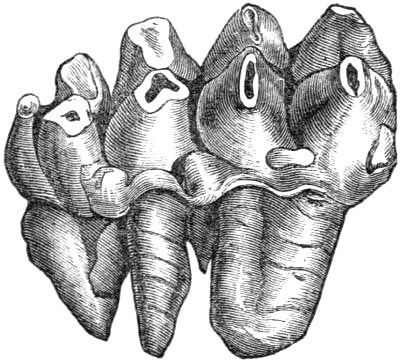
Fig. 11. – Mastodon’s Tooth (worn). (After Figuier.)
Cuvier established the name Mastodon,51 or teat-like toothed animals, for the gigantic species from America which Buffon had already described under the name of the animal or elephant of the Ohio.
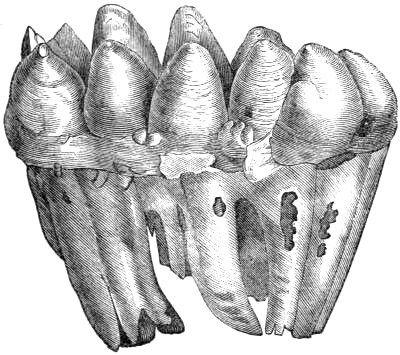
Fig. 12. – Mastodon’s Tooth. (After Figuier.)
The form first appears in the Upper Miocene of Europe, five species being known, two of them from Pikermi, near Athens, and one, M. angustidens, from the Miocene beds of Malta. Mastodon remains have also been found in the beds of the Sivalik hills, and four species of mastodon in all are known to have ranged over India during those periods.
In Pliocene deposits we have abundant remains of M. arvernensis, and M. longirostris from the Val d’Arno in Italy, and the M. Borsoni from central France.
The M. arvernensis may be considered as a characteristic Pliocene species in Italy, France, and Europe generally. In Britain it occurs in the Norwich Crag and the Red Crag of Suffolk.
Species of mastodon occur in the Pliocene of La Plata, and of the temperate regions of South America; on the Pampas, and in the Andes of Chili.
The Mastodon mirificus of Leidy is the earliest known species in America; this occurs in Pliocene deposits on the Niobrara and the Loup fork, west of the Mississippi.
The remains of the Mastodon americanus of Cuvier occur abundantly in the Post Pliocene deposits throughout the United States, but more especially in the northern half; they are also found in Canada and Nova Scotia.
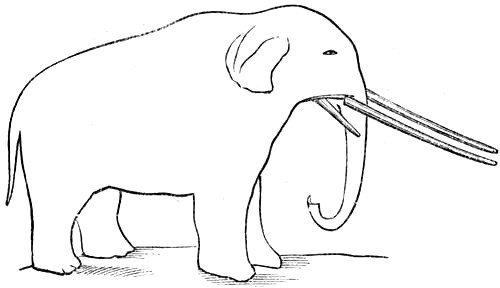
Fig. 13. – The Mastodon.
Perfect skeletons are occasionally procured from marshes, where the animals had become mired. In life this species appears to have measured from twelve to thirteen feet in height and twenty-four to twenty-five feet in length, including seven feet for the tusks. Undigested food found with its remains show that it lived partly on spruce and fir-trees. A distinct species characterised the Quaternary deposits of South America.
The Irish Elk. – The species (Megaceros hibernicus), commonly but erroneously called the Irish Elk, was, as professor Owen52 has pointed out, a true deer, whose place is between the fallow and reindeer.
Though now extinct, it survived the Palæolithic period, and may possibly have existed down to historic times. Mr. Gosse adduces some very strong testimony on this point, and is of opinion that its extinction cannot have taken place more than a thousand years ago.
It had a flattened and expanded form of antler, with peculiarities unknown among existing deer, and was, in comparison with these, of gigantic size; the height to the summit of the antlers being from ten to eleven feet in the largest individuals, and the span of the antlers, in one case, over twelve feet.
Although its remains have been found most abundantly in Ireland, it was widely distributed over Britain and middle Europe. It has been found in peat swamps, lacustrine marls, bone caverns, fen deposits, and the Cornish gravels. It has been obtained from the cavern of Goyet in Belgium, and from the burial-place at Aurignac, in the department of the Haute Garonne. Its known range in time is from the early part of the Glacial period down to, possibly, historic periods.
The Cave-Hyæna. —Hyæna spelæa of Goldfuss – is, like the cave-bear, characteristic of Europe during the Palæolithic age. It has been found in numerous caves in Britain, such as Kent’s Hole, the Brixham cave, and one near Wells in Somersetshire, explored by Dawkins in 1859; in all of these the remains are associated with those of man, or with his implements. This species is closely related to the H. crocuta of Zimm, at present existing in South Africa, and is by some geologists considered identical with it. It is, however, larger.
It appears to have to some extent replaced the cave-bear in Britain; we are also, doubtless, greatly indebted to it for some of the extensive collections of bones in caverns, resulting from the carcases which it had dragged thither, and imperfectly destroyed.
In a cave at Kirkdale, in the vale of Pickering, the bones of about three hundred individuals – hyænas – were found mingled with the remains of the mammoth, bear, rhinoceros, deer, cave-lion, brown bear, horse, hare, and other species. Mr. Dawkins,53 in describing it, says: “The pack of hyænas fell upon reindeer in the winter, and at other times on horses and bisons, and were able to master the hippopotamus, the lion, the slender-nosed rhinoceros, or the straight-tusked elephant, and to carry their bones to their den, where they were found by Dr. Buckland. The hyænas also inhabiting the ‘Dukeries,’ dragged back to their dens fragments of lion.”
Notable Quaternary forms (now extinct) on the American continent are the gigantic sloth-like animals Megatherium, which reached eighteen feet in length, and Mylodon, one species of which (M. robustus) was eleven feet in length; Armadillos, such as Glyptodon, with a total length of nine feet; Chlamydotherium, as big as a rhinoceros; and Pachytherium, equalling an ox.
In Australia we find marsupial forms as at the present day; but they were gigantic in comparison with the latter. As for example, the Diprotodon, which equalled in size a hippopotamus, and the Nototherium, as large as a bullock.
I may mention a few other species, the remains of which are associated with some of those commented on in the last few pages; but which, as they have undoubtedly continued in existence down to the present period, are external to the present portion of my argument, and are either treated of elsewhere, or need only to be referred to in a few words.
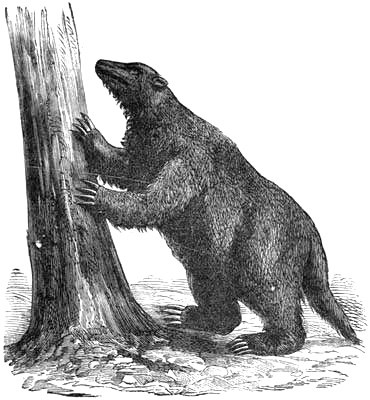
Fig. 14. – Mylodon robustus. (After Figuier.)
It must also be borne in mind that the linking together of species by the discovery of intermediate graduated forms, is daily proceeding; so that some even of those spoken of in greater detail may shortly be generally recognised, as at present they are held by a few, to be identical with existing forms.
The Hippopotamus. – The Hippopotamus major, now considered identical with the larger of the two African species —H. amphibia, has been found associated with E. antiquus and R. hemitæchus of Falc in Durdham Down and Kirkdale caves, and in those at Kent’s Hole and Ravenscliff. It has also been found in river gravels at Grays, Ilford, and elsewhere, in the lower part of the river-border deposits of Amiens with flint implements, and in Quaternary deposits on the continent of Europe.
The Cave-Lion —Felis spelæa– is now considered to be merely a variety of the African lion (Felis leo), although of larger size; it had a very wide range over Britain and Europe during the Post Pliocene period, as also did the leopard (F. pardus) and probably the lynx (Lyncus).
The Reindeer or Cariboo —Cervus tarandus– which still exists, both domesticated and wild, in northern Europe and America, is adapted for northern latitudes. It formerly extended over Europe, and in the British Isles probably survived in the north of Scotland until the twelfth century.
Its remains have been found in Pleistocene deposits in numerous localities, but most abundantly in those which M. Lartet has assigned to the period which he calls the Reindeer age.
Other Pleistocene mammals still existing, but whose range is much restricted, are the musk ox (Ovibos moschatus), familiar to us, from the accounts of arctic expeditions, as occurring in the circumpolar regions of North America; the glutton (Gulo luscus), the auroch (Bison europæus), the wild horse (E. fossilis), the arctic fox (Canis lagopus), the bison (Bison priscus), the elk or moose (Alces malchis), found in Norway and North America, the lemming, the lagomys or tail-less hare, &c.
As examples of total extinction in late years, we may mention the dodo, the solitaire, and species allied to them, in the islands of Mauritius, Bourbon, and Reunion; the moa in New Zealand; the Æpiornis in Madagascar; the great auk, Alca impennis, in northern seas, and the Rhytina Stelleri, common once in the latitude of Behring’s Straits, and described by Steller in 1742.

Fig. 15. – Skeleton of Rhytina Stelleri. (From “The Voyage of the ‘Vega.’”)
The Dodo, a native of the island of Mauritius, was about 50 lbs. in weight, and covered with loose downy plumage, it was unable to rise from the ground in consequence of the imperfect development of its wings; it was minutely described by Sir Thomas Herbert in 1634, and specimens of the living bird and of its skin were brought to Europe. Its unwieldiness led to its speedy destruction by the early voyagers.

Fig. 16. – Rhytina Stelleri. (From “The Voyage of the ‘Vega.’”)
The Solitaire was confined to the island of Mascaregue or Bourbon. It is fully described by Francis Leguat, who, having fled from France into Holland in 1689, to escape religious persecution consequent on the revocation of the Edict of Nantes, engaged under the Marquis de Quesne in an expedition for the purpose of settlement on that island. This bird also speedily became extinct.
The Moa (Dinornis giganteus, Owen) reached from twelve to fourteen feet in height, and survived for a long period after the migration of the Maories to New Zealand. Bones of it have been found along with charred wood, showing that it had been killed and eaten by the natives; and its memory is preserved in many of their traditions, which also record the existence of a much larger bird, a species of eagle or hawk, which used to prey upon it.54
Rapidly approaching total extinction are the several species of Apteryx in the same country – remarkable birds with merely rudimentary wings: as also the Notornis, a large Rail – at first, and for a long time, only known in the fossil state, but of which a living specimen was secured by Mr. Walter Mantell in 1849: and the Kapapo (Strigops habroptilus) of G. R. Gray – a strange owl-faced nocturnal ground-parrot.
The Æpyornis maximus was almost as large as the Moa; of this numerous fossil bones and a few eggs have been discovered, but there are not, I believe, any traditions extant among the natives of Madagascar of its having survived to a late period.
The Great Auk (Alca impennis) is now believed to be extinct. It formerly occurred in the British Isles, but more abundantly in high latitudes; and its remains occur in great numbers on the shores of Iceland, Greenland, and Denmark, as also of Labrador and Newfoundland.

Fig. 17. – Rhytina Stelleri. (After J. Fr. Brandt.)
Steller’s Sea-cow (Rhytina Stelleri of Cuvier) was a mammal allied to the Manatees and Dugongs; it was discovered by Behring in 1768 on a small island lying off the Kamtchatkan coast. It measured as much as from twenty-eight to thirty-five feet in length, and was soon nearly exterminated by Behring’s party and other voyagers who visited the island. The last one of which there is any record was killed in 1854.55
To the above may be added the Didunculus, a species of ground-pigeon peculiar to the Samoa Islands, and the Nestor productus, a parrot of Norfolk Island. An extended list might be prepared, from fossil evidences, of other species which were at one time associated with those I have enumerated.

Fig. 18. – Rhytina Stelleri. (From “The Voyage of the ‘Vega.’”)
In conclusion, I may point out that that excellent naturalist Pliny56 records the disappearance, in his days, of certain species formerly known. He mentions the Incendiary, the Clivia, and the Subis (species of birds), and states that there were many other birds mentioned in the Etruscan ritual, which were no longer to be found in his time. He also says that there had been a bird in Sardinia resembling the crane, and called the Gromphæna, which was no longer known even by the people of the country.
Local ExtinctionOf local extinction we may note in our own island the cases of the beaver, the bear, the wolf, the wild cattle, the elk, the wild boar, the bustard, and the capercailzie; of these the beaver survived in Wales and Scotland until the time of Giraldus Cambrensis in 1188, and Pennant notes indications of its former existence in the names of several streams and lakes in Wales. It was not uncommon throughout the greater part of Europe down to the Middle Ages.
The bear, still common in Norway and the Pyrenees, is alluded to, as Mr. Gosse points out, in the Welsh Triads,57 which are supposed to have been compiled in the seventh century. They say that “the Kymri, a Celtic tribe, first inhabited Britain; before them were no men here, but only bears, wolves, beavers, and oxen with high prominences.” Mr. Gosse adds, “The Roman poets knew of its existence here. Martial speaks of the robber Laureolis being exposed on the cross to the fangs of the Caledonian bear; and Claudian alludes to British bears. The Emperor Claudius, on his return to Rome after the conquest of this island, exhibited, as trophies, combats of British bears in the Arena. In the Penitential of Archbishop Egbert, said to have been compiled about A.D. 750, bears are mentioned as inhabiting the English forests, and the city of Norwich is said to have been required to furnish a bear annually to Edward the Confessor, together with six dogs, no doubt for baiting him.”
The wolf, though greatly reduced in numbers during the Heptarchy, when Edgar laid an annual tribute of three hundred wolf-skins upon the Welsh, still occurred in formidable numbers in England in 1281, and not unfrequently until the reign of Henry VII. The last wolf was killed in Scotland in the year 1743, and in Ireland in 1770.58
The wild cattle are now only represented by the small herds in Chartley Castle, Chillingham, and Cadgow parks; the spare survivors probably of the species referred to by Herodotus when he speaks of “large ferocious and fleet white bulls” which abounded in the country south of Thrace, and continued in Poland, Lithuania, and Muscovy until the fifteenth century, or perhaps of the Urus described by Cæsar as little inferior to the elephant in size, and inhabiting the Hercynian forest, and believed to be identical with the Bos primigenius found in a fossil state in Britain.
The wild boar was once abundant in Scotland and England. The family of Baird derives its heraldic crest from a grant of David I. of Scotland, in recognition of his being saved from an infuriated boar which had turned on him. In England only nobles and gentry were allowed to hunt it, and the slaughter of one by an unauthorized person within the demesnes of William the Conqueror was punished by the loss of both eyes.59
The bustard, once abundant, is now extinct in Britain, so far as the indigenous race is concerned. Occasionally a chance visitant from the continent is seen; but there, also, its numbers have been greatly diminished. It was common in Buffon’s time in the plains of Poitou and Champagne, though now extremely rare, and is still common in Eastern Asia.
The capercailzie, or cock of the woods, after complete extinction, has been reintroduced from Norway, and, under protection, is moderately abundant in parts of Scotland.
In America, the process of extermination marches with the settlement of the various states. W. J. J. Allen records the absolute disappearance of the walrus from the Gulf of St. Lawrence, and of the moose, the elk, and the Virginian deer, from many of the states in which they formerly abounded. This also is true, to some extent, of the bear, the beaver, the grey wolf, the panther, and the lynx.
The buffalo (Bos americanus) is being destroyed at the rate of two hundred and fifty thousand annually, and it is estimated that the number slain by hunters for their hides during the last forty years amounts to four millions. It has disappeared in the eastern part of the continent from many extensive tracts which it formerly inhabited.
Among the ocean whales, both the right and the sperm have only been preserved from extinction by the fortunate discovery of petroleum, which has reduced the value of their oil, and thus lessened considerably the number of vessels equipped for the whale fishery.
In South Africa, elephants and all other large game are being steadily exterminated within the several colonies.
In Australia, we find that the seals which thronged the islands of Bass’s Straits in countless thousands, at the period when Bass made his explorations there, have utterly disappeared. The bulk of them were destroyed by seal-hunters from Sydney within a few years after his discovery. The lamentable records of the Sydney Gazette of that period show this, for they detail the return to port, after a short cruise, of schooners laden with from twelve to sixteen thousand skins each. The result of this has been that for many years past the number of seals has been limited to a few individuals, to be found on one or two isolated rocks off Clarke’s Island, and on Hogan’s group.
The great sea-elephant, which, in Peron’s time, still migrated for breeding purposes from antarctic regions to the shores of King’s Island, where it is described by him as lining the long sandy beaches by hundreds, has been almost unseen there since the date of his visit, and its memory is only preserved in the names of Sea-Elephant Bay, Elephant Rock, &c. which are still inscribed on our charts.

